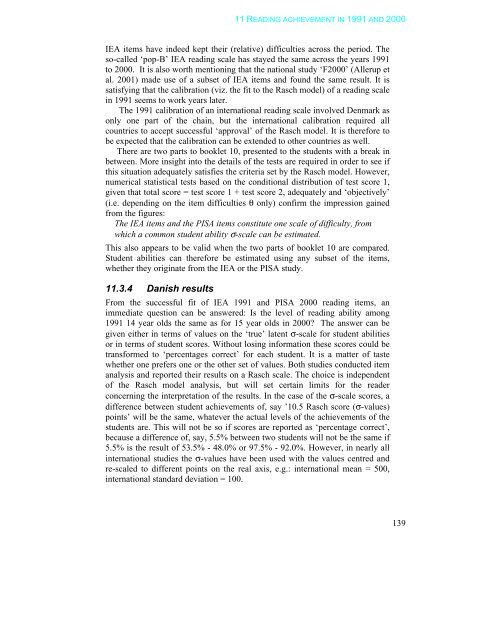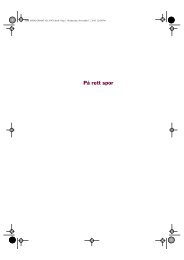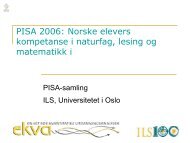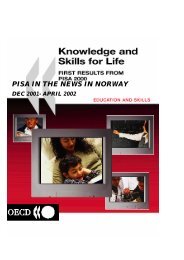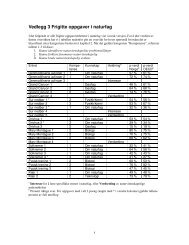11READING ACHIEVEMENT IN 1991 AND 2000 - Pisa
11READING ACHIEVEMENT IN 1991 AND 2000 - Pisa
11READING ACHIEVEMENT IN 1991 AND 2000 - Pisa
- No tags were found...
Create successful ePaper yourself
Turn your PDF publications into a flip-book with our unique Google optimized e-Paper software.
11 READ<strong>IN</strong>G <strong>ACHIEVEMENT</strong> <strong>IN</strong> <strong>1991</strong> <strong>AND</strong> <strong>2000</strong>IEA items have indeed kept their (relative) difficulties across the period. Theso-called ‘pop-B’ IEA reading scale has stayed the same across the years <strong>1991</strong>to <strong>2000</strong>. It is also worth mentioning that the national study ‘F<strong>2000</strong>’ (Allerup etal. 2001) made use of a subset of IEA items and found the same result. It issatisfying that the calibration (viz. the fit to the Rasch model) of a reading scalein <strong>1991</strong> seems to work years later.The <strong>1991</strong> calibration of an international reading scale involved Denmark asonly one part of the chain, but the international calibration required allcountries to accept successful ‘approval’ of the Rasch model. It is therefore tobe expected that the calibration can be extended to other countries as well.There are two parts to booklet 10, presented to the students with a break inbetween. More insight into the details of the tests are required in order to see ifthis situation adequately satisfies the criteria set by the Rasch model. However,numerical statistical tests based on the conditional distribution of test score 1,given that total score = test score 1 + test score 2, adequately and ‘objectively’(i.e. depending on the item difficulties θ only) confirm the impression gainedfrom the figures:The IEA items and the PISA items constitute one scale of difficulty, fromwhich a common student ability σ-scale can be estimated.This also appears to be valid when the two parts of booklet 10 are compared.Student abilities can therefore be estimated using any subset of the items,whether they originate from the IEA or the PISA study.11.3.4 Danish resultsFrom the successful fit of IEA <strong>1991</strong> and PISA <strong>2000</strong> reading items, animmediate question can be answered: Is the level of reading ability among<strong>1991</strong> 14 year olds the same as for 15 year olds in <strong>2000</strong>? The answer can begiven either in terms of values on the ‘true’ latent σ-scale for student abilitiesor in terms of student scores. Without losing information these scores could betransformed to ‘percentages correct’ for each student. It is a matter of tastewhether one prefers one or the other set of values. Both studies conducted itemanalysis and reported their results on a Rasch scale. The choice is independentof the Rasch model analysis, but will set certain limits for the readerconcerning the interpretation of the results. In the case of the σ-scale scores, adifference between student achievements of, say ’10.5 Rasch score (σ-values)points’ will be the same, whatever the actual levels of the achievements of thestudents are. This will not be so if scores are reported as ‘percentage correct’,because a difference of, say, 5.5% between two students will not be the same if5.5% is the result of 53.5% - 48.0% or 97.5% - 92.0%. However, in nearly allinternational studies the σ-values have been used with the values centred andre-scaled to different points on the real axis, e.g.: international mean = 500,international standard deviation = 100.139


